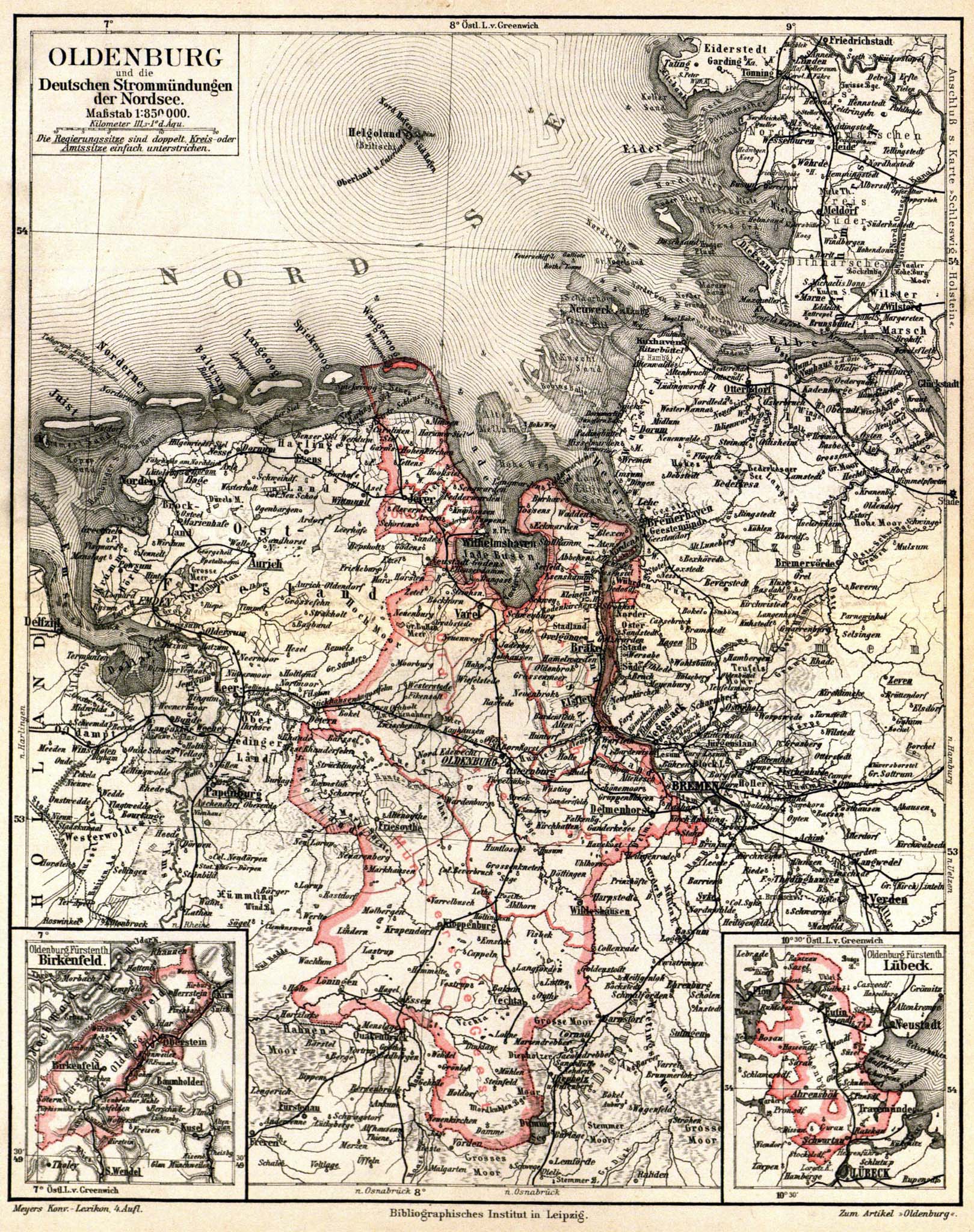|
Oldenburg–Bremen Railway
The Bremen–Oldenburg railway is a long mainline railway that connects Oldenburg in the northwest of the German states of Lower Saxony and Bremen. It is served by a daily Intercity Express service between Oldenburg and Munich, InterCity trains between Norddeich Mole, Oldenburg and Leipzig, as well as freight and regional trains. The Bremen S-Bahn also operates over the line. Route The line leaves Bremen Hauptbahnhof at its western exit and snakes through several tight bends through the former main freight yard and the "northwest node" to highway 6 passing the junctions of many freight lines to the bridge over the Weser. Until the construction of the Weser tunnel, this was the northernmost permanent crossing of the river. The line continues through Bremen-Neustadt in a westerly direction to Delmenhorst, where a busy line branches off to Vechta and Osnabrück (operated by NordWestBahn). From there it runs in a northwesterly direction towards Hude. There it connects with the ... [...More Info...] [...Related Items...] OR: [Wikipedia] [Google] [Baidu] |
Lower Saxony
Lower Saxony (german: Niedersachsen ; nds, Neddersassen; stq, Läichsaksen) is a German state (') in northwestern Germany. It is the second-largest state by land area, with , and fourth-largest in population (8 million in 2021) among the 16 ' federated as the Federal Republic of Germany. In rural areas, Northern Low Saxon and Saterland Frisian are still spoken, albeit in declining numbers. Lower Saxony borders on (from north and clockwise) the North Sea, the states of Schleswig-Holstein, Hamburg, , Brandenburg, Saxony-Anhalt, Thuringia, Hesse and North Rhine-Westphalia, and the Netherlands. Furthermore, the state of Bremen forms two enclaves within Lower Saxony, one being the city of Bremen, the other its seaport, Bremerhaven (which is a semi-enclave, as it has a coastline). Lower Saxony thus borders more neighbours than any other single '. The state's largest cities are state capital Hanover, Braunschweig (Brunswick), Lüneburg, Osnabrück, Oldenburg, Hildesheim, Salzgitt ... [...More Info...] [...Related Items...] OR: [Wikipedia] [Google] [Baidu] |
Bundesstraße 6
The Bundesstraße 6 (abbr. B6) is a German federal highway running from Bremerhaven on the North Sea coast in a southeasterly direction through the states of Lower Saxony, Bremen, Saxony-Anhalt and Saxony to Görlitz on the Polish border. History East of Leipzig, the B6 (except of the ring roads around Meißen, Dresden and Bischofswerda) largely follows the historic course of the '' Via Regia Lusatiae Superioris'', part of the medieval ''Via Regia''. In 1937, the northwestern section of the former ''Reichsstraße 6'' (R6) was extended from Bremerhaven (Wesermünde) to Cuxhaven. Before World War II and the implementation of the Oder–Neisse line, the R6 road continued southeastwards from Görlitz via Hirschberg (present-day Jelenia Góra, Poland) and Schweidnitz (Świdnica) to the Silesian capital Breslau (Wrocław) and from there via Oels (Oleśnica) as far as the former Polish border near Groß Wartenberg (Syców). The sections between Görlitz/Zgorzelec and Syc ... [...More Info...] [...Related Items...] OR: [Wikipedia] [Google] [Baidu] |
Wilhelmshaven
Wilhelmshaven (, ''Wilhelm's Harbour''; Northern Low Saxon: ''Willemshaven'') is a coastal town in Lower Saxony, Germany. It is situated on the western side of the Jade Bight, a bay of the North Sea, and has a population of 76,089. Wilhelmshaven is the centre of the "Jade Bay" business region (which has around 330,000 inhabitants) and is Germany's main military port. The adjacent Lower Saxony Wadden Sea National Park (part of the Wattenmeer UNESCO World Natural Heritage Site) provides the basis for the major tourism industry in the region. History The , built before 1383, operated as a pirate stronghold; the Hanseatic League destroyed it in 1433. Four centuries later, the Kingdom of Prussia planned a fleet and a harbour on the North Sea. In 1853, Prince Adalbert of Prussia, a cousin of the Prussian King Frederick William IV of Prussia, Frederick William IV, arranged the Jade Treaty (''Jade-Vertrag'') with the Grand Duchy of Oldenburg, in which Prussia and the Grand Duchy ente ... [...More Info...] [...Related Items...] OR: [Wikipedia] [Google] [Baidu] |
Wilhelmshaven–Oldenburg Railway
The Wilhelmshaven–Oldenburg railway is a predominantly double-track, non-electrified main line in the northwest in the German state of Lower Saxony. It runs to the south from the port city of Wilhelmshaven to Oldenburg (city), Oldenburg. The line is being upgraded in connection with the construction of JadeWeserPort so that it will be continuously duplicated and electrified. Route The Oldenburg–Wilhelmshaven line (VzG 1522) is currently duplicated with the exception of two sections, Varel–Jaderberg and Hahn–Rastede, and is designed for a top speed of 120 km/h. History The track was a joint project of the Grand Duchy of Oldenburg State Railways and the Prussian state railways and was built together with the Oldenburg–Bremen railway, Oldenburg–Bremen line. It linked the Prussian naval base in Wilhelmshaven (then called Heppens) and opened up the north of the Grand Duchy of Oldenburg, Grand Duchy. It was officially opened on 18 July 1867, but scheduled services s ... [...More Info...] [...Related Items...] OR: [Wikipedia] [Google] [Baidu] |
Prussian State Railways
The term Prussian state railways (German: ''Preußische Staatseisenbahnen'') encompasses those railway organisations that were owned or managed by the State of Prussia. The words "state railways" are not capitalized because Prussia did not have an independent railway administration; rather the individual railway organisations were under the control of the Ministry for Trade and Commerce or its later offshoot, the Ministry for Public Works. The official name of the Prussian rail network was ''Königlich Preußische Staatseisenbahnen'' (K.P.St.E., "Royal Prussian State Railways") until 1896, ''Königlich Preußische und Großherzoglich Hessische Staatseisenbahn'' (K.P.u.G.H.St.E., " Royal Prussian and Grand-Ducal Hessian State Railways") until the end of the First World War, and ''Preußische Staatsbahn'' (P.St.B., "Prussian State Railway") until its nationalization in 1920. A common mistake is the use of the abbreviation K.P.E.V. in supposed reference to a mythical "Royal Prussian ... [...More Info...] [...Related Items...] OR: [Wikipedia] [Google] [Baidu] |
Grand Duchy Of Oldenburg State Railways
The Grand Duchy of Oldenburg Railway (''Großherzoglich Oldenburgische Eisenbahn or GOE'') was the railway company that was run as a state railway for the Grand Duchy of Oldenburg (''Großherzogtum Oldenburg''), part of the German Empire. History Compared with the other states in the German Empire, Oldenburg's first railway line arrived relatively late. In this sparsely populated and economically poor area, the construction of railways appeared for a long while to be unsustainable due to the financial costs. In addition, the various ideas of its neighboring states, Hanover and Prussia prevented railway projects from coming to fruition for a long time. Finally in 1864 a treaty was agreed between Prussia and Oldenburg over the construction of a railway line from Bremen to Oldenburg. At the same time Prussia committed itself to building a railway line from Heppens – later Wilhelmshaven – to Oldenburg (the Wilhelmshaven–Oldenburg line). The Grand Ducal Railway Commission, set ... [...More Info...] [...Related Items...] OR: [Wikipedia] [Google] [Baidu] |
Bascule Bridge
A bascule bridge (also referred to as a drawbridge or a lifting bridge) is a moveable bridge with a counterweight that continuously balances a span, or leaf, throughout its upward swing to provide clearance for boat traffic. It may be single- or double-leafed. The name comes from the French term for balance scale, which employs the same principle. Bascule bridges are the most common type of movable span because they open quickly and require relatively little energy to operate, while providing the possibility for unlimited vertical clearance for marine traffic. History Bascule bridges have been in use since ancient times, but until the adoption of steam power in the 1850s, very long, heavy spans could not be moved quickly enough for practical application. Types There are three types of bascule bridge and the counterweights to the span may be located above or below the bridge deck. The fixed-trunnion (sometimes a "Chicago" bascule) rotates around a large axle that raises the ... [...More Info...] [...Related Items...] OR: [Wikipedia] [Google] [Baidu] |
Hunte
Hunte is a long river in north-western Germany (Lower Saxony), a left tributary of the Weser. The Hunte rises in the Wiehen Hills. In the North German Plain it flows through lake Dümmer. It flows generally northwards through the towns Bad Essen, Diepholz, Wildeshausen and Oldenburg. It flows into the Weser in Elsfleth. The part between Oldenburg and the Weser is navigable for coastal cargo ships. The Küsten Canal, suitable for inland navigation only, links the Hunte in Oldenburg to river Ems near Papenburg. Catchment The catchment of the Hunte is relatively narrow (its maximum width is about ) and it extends from south to north mainly within the state of Lower Saxony but also to a small extent in North Rhine-Westphalia (counties of Minden-Lübbecke and Herford) for a length of about . The highest point of the catchment area is the Nonnenstein in the Wiehen Hills (), the lowest regions of the catchment lie within the marshes on the lower Hunte (partly below sea level). ... [...More Info...] [...Related Items...] OR: [Wikipedia] [Google] [Baidu] |
Oldenburg–Osnabrück Railway
The Oldenburg–Osnabrück railway is a single-track, non-electrified railway line from Oldenburg to Osnabrück, both in the German state of Lower Saxony. The line was opened in two stages between 1875 and 1876. The first section from Oldenburg to Quakenbrück was built between 1870 and 1875 by the Grand Duchy of Oldenburg State Railways (GOE). The opening of the first section took place on 15 October 1875. The section from Quakenbrück to Osnabrück-Eversburg, then passing through Prussian territory, opened only a year later, on 30 June 1876. The official opening took place on 15 November 1876. Until the mid-1990s there was a modest long distance train connection over the line. There was a daily express train from Koblenz and Cologne to Wilhelmshaven and a train from Mönchengladbach to Wilhelmshaven. Since 2000, the infrastructure was expanded to introduce a train service with shorter journey times and better connections. Part of the development was to increase the maximum li ... [...More Info...] [...Related Items...] OR: [Wikipedia] [Google] [Baidu] |
Nordenham
Nordenham () is a town in the Wesermarsch district, in Lower Saxony, Germany. It is located at the mouth (on the west bank) of the Weser river on the Butjadingen peninsula on the coast of the North Sea. The seaport city of Bremerhaven is located on the other side (east bank) of the river. The Midgard-seaport in Nordenham is the largest private-owned harbor in Germany. Geography Geographical location Nordenham is located on the West Bank of the Weser River across from Bremerhaven along the river's mouth at the North Sea, north of the cities of Bremen and Oldenburg. The local environment is mainly marshland, specifically ''Marsch oder Schwemmland''. Boroughs Nordenham is composed of 35 districts, each with a long history as a separate community: Abbehausen, Abbehauser Groden, Abbehauser Hörne, Abbehauserwisch, Atens, Atenserfeld, Blexen, Blexersande, Blexerwurp, Bulterweg, Butterburg, Einswarden, Ellwürden, Enjebuhr, Esenshamm, Esenshammer Altendeich, Esenshammer Oberdeich, Es ... [...More Info...] [...Related Items...] OR: [Wikipedia] [Google] [Baidu] |
NordWestBahn
The NordWestBahn GmbH is a private railway company providing regional train services on several routes in northern and western Germany. It is a joint venture of Stadtwerke Osnabrück AG, Verkehr und Wasser GmbH in Oldenburg and Transdev Germany, Berlin. The head office of the company is in Osnabrück. NWB claims to be Germany's largest regional railway company. Since 5 November 2000, NordWestBahn operates, on behalf of the public transport company of Lower Saxony (Landesnahverkehrsgesellschaft Niedersachsen - LNVG), the Weser-Ems-Network in Lower Saxony. In March 2008, NordWestBahn won the tender for the regional S-Bahn Bremen/Lower Saxony, defeating German National railway operator DB Regio DB Regio AG is a subsidiary of Deutsche Bahn which operates regional and commuter train services in Germany. DB Regio AG, headquartered in Frankfurt am Main. It is a 100% subsidiary of the Deutsche Bahn Group and there part of the DB Regio bus .... Operation of these routes started ... [...More Info...] [...Related Items...] OR: [Wikipedia] [Google] [Baidu] |






